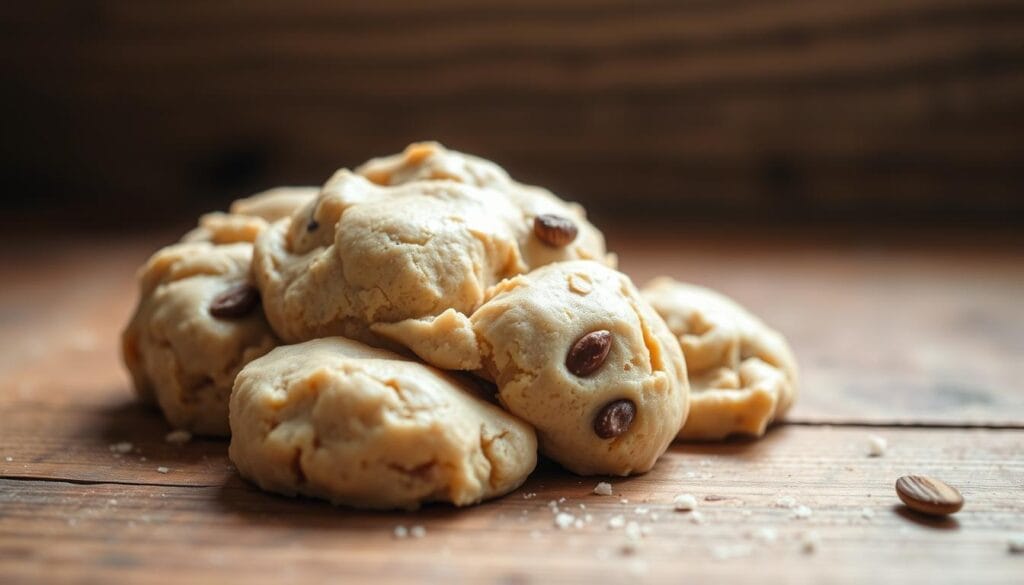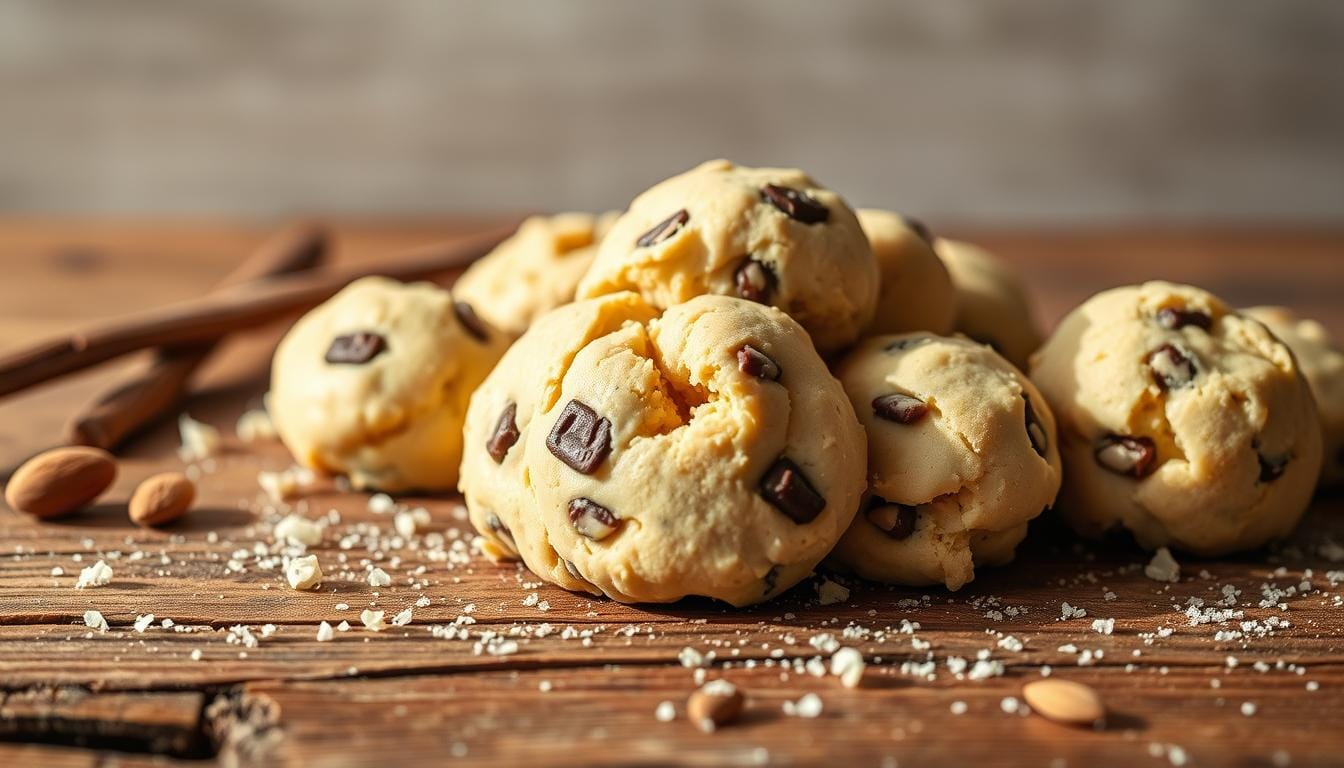Satisfy Cravings Guilt-Free: Sugar-Free Cookie Dough
Imagine enjoying rich, gooey cookie dough without the guilt. Brands like Good Dee’s make this dream a reality. Their sugar-free cookie dough has only 2g net carbs per bite and no added sugar.
Imagine a 20-minute recipe that makes fudgy dough with 15g of chocolate chips. It’s made from almond flour, erythritol, and stevia. This isn’t just a diet substitute; it’s a new way to enjoy dessert.
Table of Contents
Key Takeaways
- Sugar-free cookie dough offers 2g net carbs per serving, fitting keto and low-carb diets.
- Good Dee’s mixes use almond flour and erythritol, avoiding maltitol for a grain-free, gluten-free option.
- Ready in 20 minutes, it delivers a creamy texture with 24g total carbs but only 2g net carbs due to high fiber.
- Perfect for dieters seeking 5g protein per serving and 2g fiber to support gut health.
- Stays true to classic cookie dough taste with vanilla and chocolate chips, now guilt-free.
What is Sugar-Free Cookie Dough?
Sugar-free cookie dough uses natural sweeteners like stevia or erythritol instead of refined sugars. This way, you can enjoy a sweet treat without the blood sugar spikes. It’s perfect for diets like keto or low-carb because it has no added sugar.
Understanding Sugar Substitutes Options
- Stevia extracts zero-calorie sweetness from plant leaves.
- Erythritol, a sugar alcohol, adds bulk without the calories of sugar.
- Monk fruit sweeteners provide natural sweetness with minimal carbs.
- Allulose mimics sugar’s texture while avoiding insulin spikes.
Nutritional Benefits of Sugar-Free Options
Compared to classic Toll House cookie dough (11.4g carbs per serving), sugar-free versions cut carbs to just 1g per 2 tablespoons. This dip recipe contains 134 calories and 1g net carbs per serving, ideal for low-carb diets. Natural sweeteners also avoid artificial additives, making treats safer for those monitoring sugar intake.
Protein and fiber in some recipes, like almond flour blends, add satiating nutrients. For example, homemade bites have 1.6g fiber per ball, helping curb cravings longer than sugary snacks.
The Rise of Healthy Baking Alternatives
Health-conscious eating doesn’t mean giving up sweets. Over 91% of people now look for products with less sugar. This push for healthy treats is changing the baking world.
Trends in Health-Conscious Treats
Keto, paleo, and low-carb diets are big now. The UK government wants to cut sugar, and people are learning about sugar’s health effects. Social media, like Instagram and TikTok, has made these trends even bigger.
Brands are using new ingredients to cut sugar by up to 50%. They keep the treats tasty without adding extra sugar.
Consumers Seeking Guilt-Free Indulgence
Today, people want guilt-free dessert options that taste great. Over 50% of shoppers look for recipes with healthier ingredients like dates or flax seeds. Companies like Enjoy Life and Nature’s Path offer sugar-free mixes that make delicious cookies with natural sugars.
Flavor is still the top choice for 51% of consumers. Brands like Just Date Orchards show it’s possible to make tasty, healthy treats. With more people watching their macros and avoiding refined sugars, this trend is here to stay.
Key Ingredients in Sugar-Free Cookie Dough
Creating sugar-free cookie dough requires the right ingredients. We’ll explore the key components that make treats sweet and fit dietary needs.
Popular Sugar Substitutes
Natural sweeteners like erythritol, stevia, and monk fruit are great alternatives to sugar. Swerve and Lakanto blends mix erythritol with allulose or monk fruit for a balanced taste.
- Erythritol: 70% as sweet as sugar, no aftertaste
- Stevia: 200x sweeter, use sparingly to avoid bitterness
- Monk fruit: Clean taste but less sweet than sugar
Adjust sweetness by choosing 1–2 tablespoons of powdered sweetener in recipes.
Choosing the Right Flours
Low carb options like almond flour and coconut flour are key for texture. Gluten-free flours ensure safety and keep things moist. Add ¼ cup dark sugar-free chocolate chips for extra richness. Coconut oil or melted butter adds creaminess, while vanilla extract balances flavors.
Each cookie dough ball (15g) has 74 kcal, 3g total carbs, and 1.4g net carbs.
Pro tip: Blend almond flour with ½ tsp vanilla and ¼ cup double cream for a fudgy texture. Always check labels for gluten-free certifications when selecting flours.
Flavor Variations to Explore
Make sugar free cookie dough your own. Try rich chocolate or crunchy textures. Here’s how to make healthy treats that taste great:
Classic Chocolate Chip
Chocolate fans will love sugar-free chips sweetened with stevia or erythritol. The Crazy Edible Cookie Dough recipe calls for ½ cup of these chips. But, you can use 85% dark chocolate chunks for a low-carb option. Remember, mix chips well into the dough.
- Stir in 2 tbsp cocoa powder for more flavor
- Adjust chocolate from ¼ to ½ cup based on your taste
Fun Additions Like Nuts and Dried Fruit
Add textures and nutrients with fun ingredients. Try:
| Ingredient | Benefits |
|---|---|
| Nuts (almonds, walnuts) | Adds protein and healthy fats |
| Pumpkin seeds | Rich in magnesium and zinc |
| Unsweetened dried cranberries | Natural tang and antioxidants |
Try seasonal flavors like cinnamon in fall or peppermint in winter. For a savory twist, add sea salt or espresso powder. The Monster Cookie mix with M&Ms, chocolate chips, and peanut butter is a hit. Always chill mix-ins before blending to keep the dough from getting soggy.
“With a 4.72/5 rating, the Crazy Edible Cookie Dough proves mix-ins like dark chocolate and nuts boost satisfaction in sugar free cookie dough.”
How to Use Sugar-Free Cookie Dough
Enjoy sugar free cookie dough to the fullest with these easy tips. Whether baking or eating it raw, follow these steps for the best results and safety.
Baking Tips for Perfect Cookies
- Preheat to 325°F for even cooking due to alternative flours and sweeteners.
- Bake 8–10 minutes—check for firm edges, not browning, since sugar-free dough doesn’t caramelize.
- Use parchment paper to prevent sticking; almond flour may spread less than wheat-based doughs.
Eating Raw: Is It Safe?
Raw consumption needs careful steps. Always:
- Heat-treat flour: Spread flour on a sheet pan at 325°F for 8–10 minutes, then cool completely.
- Use pasteurized eggs or egg replacers like flaxseed.
- Opt for pre-made diabetic-friendly brands like Enjoy Life’s flourless cookie dough for guaranteed safety.
| Nutrient | Amount per Serving |
|---|---|
| Calories | 148 kcal |
| Carbohydrates | 1g |
| Protein | 3g |
| Fat | 13g |
| Fiber | 2g |
| Sugar | 1g |
Store baked cookies at room temperature for 3 days, or freeze for up to 3 months. For raw dough, keep refrigerated up to 5 days. Thaw frozen dough overnight in the fridge.
Where to Buy Sugar-Free Cookie Dough
Looking for sugar free cookie dough? Check out online and local stores to find what you need. This way, you can enjoy your treats without straying from your diet.
Popular Brands Available Online
Skinny Mixes is a big name in diabetic-friendly cookie dough online. Their products are also keto-friendly and gluten-free, made right here in the USA. You can get discounts: save 5% on 3+ units or 10% on 12+ orders. Find these goodies on Amazon, Thrive Market, or the brand’s official website.

| Product | Serving Size | Calories | Gluten-Free |
|---|---|---|---|
| Skinny Mixes Cookie Dough | 2 tbsp | 0 kcal | Yes |
| Keto-Friendly Dough | 2 tbsp | 0 kcal | Yes |
Local Grocery Store Options
For sugar free cookie dough, check the health or refrigerated aisles at Whole Foods or Target. Look for keto or diabetic-friendly seals on the labels. Stock up during holidays for baking. Compare store brands with national ones for better deals.
Making Your Own Sugar-Free Cookie Dough
Take control of your ingredients and create low carb treats at home with these simple recipes. Whether you’re following a diabetic cookie recipe or seeking gluten-free options, these steps ensure delicious results tailored to your needs.
Easy Recipes to Try at Home
Start with this versatile base recipe, adaptable to dietary goals:
- Basic Sugar-Free Dough: Mix ½ cup almond flour, ¼ cup erythritol, 1 egg, and 1 tsp vanilla extract. Add 2 tbsp sugar-free chocolate chips.
- Diabetic-Friendly Option: Use the provided data’s recipe: 1½ cups almond flour, ⅓ cup stevia blend, ¼ cup coconut oil, and 14g dark chocolate chips. No baking required!
Nutritional comparison:
| Traditional Nestlé Dough | Sugar-Free Version |
|---|---|
| 87 calories/serving | 143 calories/serving |
| 11.4g carbs | 6g net carbs |
| High sugar | 0g added sugar |
Essential Tools for Preparation
Equip your kitchen with these basics:
- Mixing bowls and spatulas
- Dry measuring cups and spoons
- Airtight containers for storage
For advanced prep, consider a food processor to grind nuts into flour or a kitchen scale for precise measurements. A silicone spatula ensures no dough waste.
Storage tips: Keep dough in the fridge up to 5 days or freeze for 30 days. Adjust sweeteners like using monk fruit for a low carb boost. Experiment with mix-ins like coconut flakes or protein powder for extra nutrition.
Health Benefits Compared to Regular Cookie Dough
Choosing sugar-free cookie dough has real health benefits. Let’s see how these treats stack up against the regular kind.
Lower Caloric Content
- Sugar-free versions cut calories by using zero-calorie sweeteners like stevia or monk fruit.
- Almond or coconut flour adds fiber without extra carbs, making them less calorie-dense.
| Comparison | Regular Dough | Sugar-Free Option |
|---|---|---|
| Calories (per ¼ cup) | 220-250 | 168 |
| Total Carbs | 35-40g | 26.8g |
| Sugar Content | 20-25g | 14.3g |
Reduced Risk of Sugar Spikes
Diabetic-friendly options use sweeteners with zero glycemic impact. For example:
- Stevia has a glycemic index of 0 vs. sugar’s 65.
- Flaxseeds and chia seeds slow sugar absorption, stabilizing blood glucose levels.
Regular dough’s refined sugars cause sharp insulin spikes. Sugar-free versions avoid this. Look for brands like Enjoy Life or Thrive Market that focus on diabetic-friendly ingredients. Always check labels for keto-friendly options with under 5g net carbs per serving.
Sugar-Free Cookie Dough for Special Diets

Make sugar-free cookie dough that fits your diet. Find options for keto, gluten-free, or low carb diets. You don’t have to give up on taste.
Keto-Friendly and Low Carb Options
Low carb recipes are all about high fat and few carbs. Use sweeteners like erythritol, almond flour, and coconut oil. Here’s what each bite delivers:
| Serving Size | Calories | Net Carbs | Fat | Protein |
|---|---|---|---|---|
| 1 ball (15g) | 74 kcal | 1.4g | 6.9g | 1.9g |
| 2 balls (30g) | 148 kcal | 2.8g | 13.8g | 3.8g |
“Stay on track with your keto lifestyle while enjoying our keto-friendly syrups and mixes, carefully crafted for low-carb diets.”
Gluten-Free Variants
Gluten-free options use flours like almond, coconut, or certified oat. Make sure to use dedicated equipment to avoid cross-contamination. Choose from:
- Almond flour: Adds crunch and nutty flavor
- Coconut flour: Absorbs moisture, use in small amounts
- Oat flour (certified gluten-free): Light texture
- Tiger nut flour: Nut-free alternative
Adapt further by swapping butter for coconut oil (dairy-free) or using flax eggs. Always check labels for cross-contamination warnings.
The Importance of Label Reading
When picking no added sugar or diabetic-friendly cookie dough, labels are crucial. They help us make informed choices. Let’s learn how to read them correctly.
Identifying Hidden Sugars
Companies often hide sugar under many names. Don’t trust “sugar-free” labels. Look for these names instead:
- Dextrose
- Maltose
- Coconut sugar
- Agave nectar
Even “sugar-free” items can have carbs or calories. The FDA lists ingredients by weight. So, if “evaporated cane juice” is high up, it’s not sugar-free.
Understanding Ingredients List
It’s important to know the difference between artificial and natural sweeteners. Here’s a comparison:
| Type | Examples | Considerations |
|---|---|---|
| Artificial | Aspartame, sucralose | Zero calories but may cause digestive issues |
| Natural | Stevia, monk fruit | Lower glycemic impact |
Watch out for additives like xanthan gum and calcium propionate. Also, check for allergens like nuts or soy. For diabetic-friendly options, look for fiber and net carb counts. Aim for ≤5% DV for sodium and saturated fats.
Consumer Reviews and Experiences
Over 2,126 reviews and a 4.35-star rating show sugar-free cookie dough is a hit. It’s perfect for those looking for guilt-free dessert options. Let’s dive into real feedback to find the best choices.
Popular Products and Their Ratings
Flavors like Vanilla and Chocolate Chip are customer favorites. People love the healthy treats for their taste and texture. But, 18.88% mention sometimes finding gritty textures.
Here are some top picks:
- Vanilla: Cited 6 times as a top flavor for its creamy taste.
- Chocolate Chip: Praised for balancing sweetness without artificial aftertaste.
- Pumpkin Pie: A seasonal favorite with 100% helpful reviews.
Flavor consistency is key, with 19.14% of feedback focusing on taste. Yet, 10.49% mention packaging issues like seal problems.
What People Love About Sugar-Free Options
Many call it a “game-changer” for snacking. A parent shared:
“My kids ask for this instead of ice cream—it’s a win for everyone!”
Reviews with 4-5 stars show it’s great for keto and low-carb diets. It doesn’t sacrifice indulgence.
While texture is still improving, 90% say it’s worth the switch. Families and gift-givers love it. It’s more than a guilt-free dessert—it’s a versatile healthy treats option.
FAQs About Sugar-Free Cookie Dough
Ready to try sugar-free cookie dough but not sure where to begin? Here’s a quick guide to common questions and tips for beginners.
Common Questions Answered
Is sugar-free cookie dough safe for diabetics? Many diabetic cookie recipes use low-carb sweeteners like erythritol. But, always check the net carb counts. It’s best to work with a healthcare provider to adjust your diet.
Does it taste like regular dough? Modern blends with monk fruit or allulose taste very close to sugar. Brands like Enjoy Life offer dough that’s almost identical in texture. Baking works best at 375°F, with 8-10 minute bake times. Remember to chill the dough for 10 minutes first.
Storage: keep it refrigerated for up to 5 days or freeze for up to 6 months. For keto diets, make sure net carbs are under your daily limit. Most recipes have 1-3g per serving.
Tips for New Users
Begin with small batches to test your flavor preferences. Gradually switch from regular to sugar-free dough to adjust your taste buds. Store dough in airtight containers—add ½ tsp oil if it feels dry.
Try mixing almond flour for moisture or vanilla extract to enhance sweetness. Even with sugar free cookie dough, portion control is key—stick to 2-3 bites at a time. Need texture fixes? Add a splash of milk or coconut oil.
Experiment with brands like Just Date Pies or Better Bake’s mixes to find your favorite. Always follow storage guidelines for freshness.
FAQ
What is sugar-free cookie dough?
What are common sugar substitutes in sugar-free cookie dough?
How do sugar-free cookie dough and traditional cookie dough compare nutritionally?
Can I eat sugar-free cookie dough raw?
Where can I buy pre-made sugar-free cookie dough?
Are there tips for making sugar-free cookie dough at home?
What should I look for on the labels of sugar-free products?
How can sugar-free cookie dough fit into special diets?
What are some popular brands of sugar-free cookie dough?
What feedback do consumers give about sugar-free cookie dough?
Tried It? Loved It? Leave a Review!
There are no reviews yet. Be the first one to write one.






